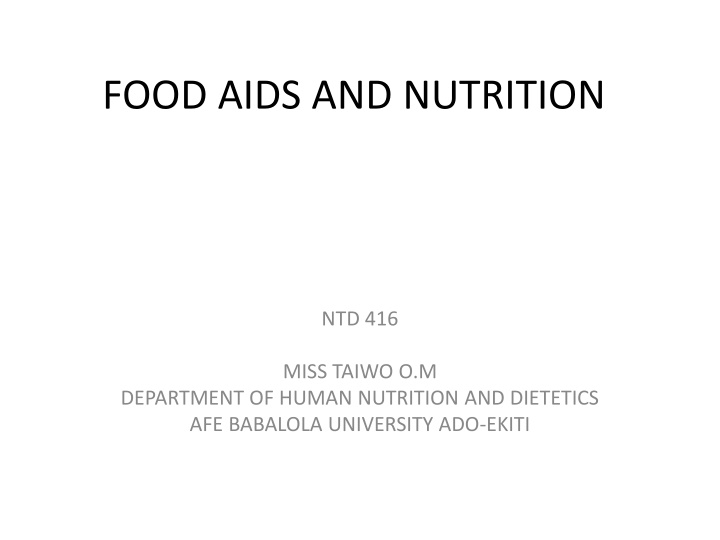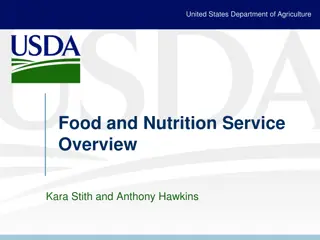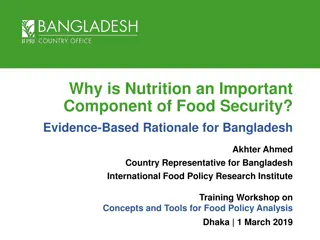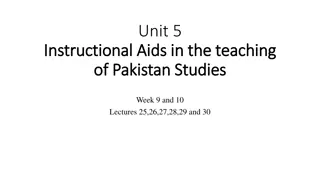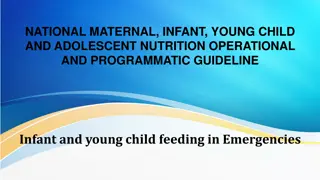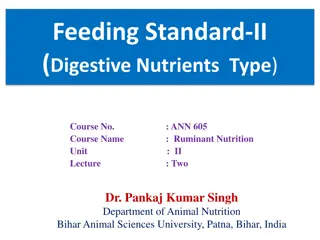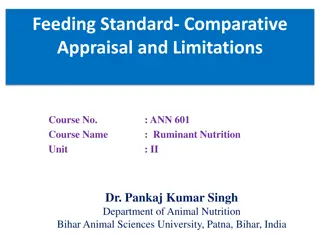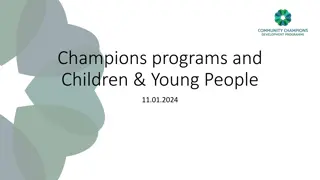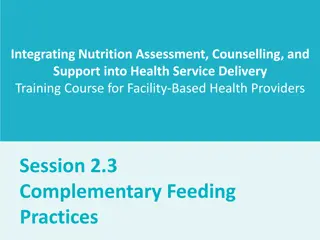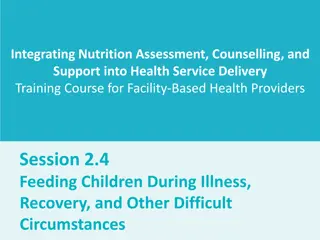Types of Feeding Programmes in Food Aids and Nutrition
General Food Distribution (GFD) is a crucial aspect of aiding populations in emergencies with food rations. It aims to cover immediate basic food needs, prevent malnutrition and death, and restore regular livelihoods. The distribution can be complete or targeted, adapting rations to family sizes and situations. Including various food commodities like cereal grains, legumes, canned meats, and high-energy biscuits is vital. Factors influencing commodity selection include nutritional considerations, environmental conditions, and risks of deficiency diseases. Acceptability, familiarity, storage, quality control, and ease of preparation of food items are other critical factors to be considered.
Download Presentation

Please find below an Image/Link to download the presentation.
The content on the website is provided AS IS for your information and personal use only. It may not be sold, licensed, or shared on other websites without obtaining consent from the author.If you encounter any issues during the download, it is possible that the publisher has removed the file from their server.
You are allowed to download the files provided on this website for personal or commercial use, subject to the condition that they are used lawfully. All files are the property of their respective owners.
The content on the website is provided AS IS for your information and personal use only. It may not be sold, licensed, or shared on other websites without obtaining consent from the author.
E N D
Presentation Transcript
FOOD AIDS AND NUTRITION NTD 416 MISS TAIWO O.M DEPARTMENT OF HUMAN NUTRITION AND DIETETICS AFE BABALOLA UNIVERSITY ADO-EKITI
GENERAL FOOD DISTRIBUTION (GFD) is when a food ration is distributed to households affected by an emergency. When there are acute and severe food shortages resulting in high mortality and malnutrition rates (or the risk of these). Objectives Cover the immediate basic food needs of an entire population group and avoid famine. Prevent deterioration of nutritional status and death. Restore and maintain regular livelihood.
Advantages General GFD (complete coverage of large populations) or targeted GFD (e.g. regions, groups, displaced) adapted to situation. Complete rations (totally covering food needs) or partial rations are given depending on the situation. Rations are adapted to family size. Constraints Difficult and slow to organize. Requires significant resources (large amounts of food, heavy logistics, numerous staff etc.). Can be subject to abuse.
TYPE OF FOOD COMMODITIES TO BE INCLUDED IN THE FOOD RATION Types of foods to be included in the food ration are: Cereal grains Legumes Canned meat, cheese and dried fish Fortified blended foods Corn Soy Blend Plus Sugar Salt High Energy Biscuits (HEB)
Factors to be considered when selecting commodities for a food ration 1. Nutritional and dietary considerations: Foods supplied in the ration must be nutritionally complementary to the foods people obtain for themselves. 2. Environmental Conditions: Populations in need of food support may be living in conditions that influence the selection of commodities. 3. Risk of Micronutrient Deficiency Diseases: Populations who are dependent on general food rations with little or no opportunity to access other foodstuffs, especially fruits and vegetables, are at risk of developing micronutrient deficiency diseases
4. Acceptability and familiarity of the food items: Wherever possible, the staple food should be acceptable and familiar to the recipients. 5. Storage, quality control and specifications: All foods distributed must be fit for human consumption and meet certain quality specifications. 6. Food processing and preparation: Food commodities should be easy and quick to prepare and cook.
SELECTIVE FEEDING PROGRAMME There are two forms of Selective Feeding Programme Supplementary Feeding Programme Therapeutic Feeding Programme
Food Aid Commodities for Selective Feeding Programmes Therapeutic Milk Breast milk substitutes Fortified blended foods Ready-to-Use Therapeutic Foods (RUTF) Ready-to-Use Supplementary Foods (RUSF) Other Commodities Included in Selective Feeding Programmes
a. Supplementary Feeding Programmes (SFP) Supplementary feeding is the provision of nutritious rations to targeted individuals that supplement the energy and nutrients missing from the diet of those with higher nutritional needs (such as pregnant women, lactating women with infants under 6 months), or those who are moderately malnourished. Short-term measures Should not be seen as a means of compensating for an inadequate general food ration Objective Reduce morbidity among moderately malnourished patients. Treat moderate malnutrition. Prevent severe malnutrition
Types of SFP Depending on the prevalence of malnutrition and availability of partners, supplementary feeding can be provided through: i. Blanket supplementary feeding ii. Targeted supplementary feeding
i. Blanket supplementary feeding Blanket SFPs provide food as a temporary measure to all vulnerable members of a population at risk of becoming malnourished without identifying the most malnourished. Objectives Prevent deterioration of nutritional situation. Reduce prevalence of acute malnutrition in children under 5 years Ensure safety net measures Reduce mortality and morbidity risk
Target group for Blanket SFP - Children under 3 or under 5 years - All pregnant women (from date of confirmed pregnancy) and nursing mothers (until maximum 6 months after delivery) - Other at-risk groups
When to start Blanket SFP At onset of an emergency Problem delivering/distributing general ration. Prevalence of acute malnutrition =/>15%. Prevalence -10-14% acute malnutrition in presence of aggravating factors. Anticipated increase in rates of malnutrition - epidemics. In case of micronutrient deficiency outbreak
ii. Targeted supplementary feeding Targeted SFPs provide a food supplement to moderately malnourished individuals to prevent them from becoming severely malnourished and to rehabilitate them. Objectives Correct moderate malnutrition. Prevent moderately malnourished from becoming severely malnourished Reduce mortality and morbidity risk in children under 5 years Provide nutritional support to selected pregnant women and nursing mothers. Provide follow up services to those discharged from therapeutic feeding programmes
Target group for Targeted SFP mild and moderately malnourished individuals (<5 & >5yrs )and for selected pregnant and nursing mothers and individuals at-risk.
When to Start Targeted SFP Malnourished individuals - prevalence of 10-14% Large numbers of children predicted to become malnourished - prevalence of 5-9% acute malnutrition in presence of aggravating factors
Forms of distribution of SFP Supplementary food can be distributed in two ways 1) On-site feeding or wet ration: minimum of two or three meals should be provided per day. 2) Take-home or dry ration: The regular (weekly or biweekly) distribution of food in dry form to be prepared at home
Advantages and disadvantages of dry rations versus wet rations Dry take-home ration Wet on-site ration Advantages -Easy access for populations living in remote areas. - Lower population concentration. - Easier to implement and to organize. - Fewer resources needed. - Less time consuming for carers. - Less defaulting and better coverage. - Family remains responsible for feeding. - Less risk of food looting in insecure situations. - Allows for closer individual medical follow-up. - Lessens burden on family for firewood and water. Disadvantages - Risk of food looting after distribution in insecure situations. - Higher quantity of food necessary per patient. - Risk of incorrect preparation of food given. - Family may share the ration when general food is limited. - Only reaches people who live near the feeding centre. - Higher risk of cross-infection. - Heavy on logistics, staff and time. - Risk of skipping meals at home. - Risk of defaulting, low attendance and low coverage (time consuming for carers).
b. Therapeutic Feeding programme (TFP) Therapeutic Feeding Programmes (TFP) to rehabilitate severely malnourished persons and thus reduce excess mortality. Objective: Reduce excess mortality and morbidity risk in children under 5 years Provide medical/nutritional treatment for the severely malnourished
When to Start TFP When the number of severely malnourished individuals cannot be treated adequately in other facilities. The availability of trained health staff is a prerequisite for establishing TFPs.
Criteria for Admission to Therapeutic Feeding Program Children younger than 5 years - severely malnourished and/or children with edema. Severely malnourished children older than 5 years, adolescents and adults Low birth weight (LBW) babies Orphans younger than one year Mothers of children younger than one year with breastfeeding failure
Criteria for Discharge from Therapeutic Feeding Program The common procedure is to refer a child to a targeted SFP when he/she: Maintains a weight-for-height >= -2.5 Z-score for two consecutive weeks. Shows a good appetite and is free of illness.
Nutritional Rehabilitation Phase 1: Acute phase (intensive care) - In 24-hour inpatient intensive care- treatment to control infection and dehydration - Electrolyte balance is restored and nutritional treatment is initiated. - Very frequent feeds with therapeutic milk (10-12 per day) - Phase should not be extended beyond one week
Phase 2: Rehabilitation phase - Providing at least 6 meals per day in order to regain most of the weight loss. - Psychological and medical care is vital - Phase not expected to last more than five weeks If the child does not gain weight during this period the implementation of the feeding regime should be reviewed. If this is not the reason for lack of weight gain, there may be other underlying causes which should be addressed accordingly.
